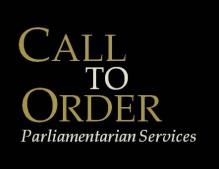In Mr. Smith Goes to Washington, the naïve Mr. Smith yields the Senate floor out of courtesy to a colleague, In doing so he loses his ability to debate on his legislation to prevent graft and corruption, Mr. Smith learned the hard way about the importance of knowing procedural rules. Officers and members of boards and and associations need to know the rules of order to achieve their goals and help their enterprises succeed. Our expertise includes:
- Meeting and Session Governance Services
- Presiding Officer Services
- Delegate Convention or Assembly Services
- Strategic Procedural Planning Services
- Bylaw Drafting, Review, and Revision Services
- Written Opinions Services
- Training Programs
The presiding officer, that is, the person running a meeting, should always attempt to know every motion that may be made and the vote required for adoption. As discussed in the article When is a majority a majority?, the majority depends in part on whether abstentions get counted. More generally, the vote needed to determine a question depends on the basis which has two parts: the proportion required and the number to which the proportion is applied. This is called the basis.
The basis can vary depending on the circumstances. The most common bases for determining passage are a majority of the votes cast, a majority of those present, or a majority of the entire membership. One consideration of using a majority of those present is that an abstention is actually a negative vote. A member that seeks to remain neutral on a question cannot under these circumstances. A majority of the entire membership as a basis is clearly a very high bar particularly if the membership is large and dispersed over a large geographic area. Other proportions aside from a majority are a two-thirds vote or perhaps even a 75% rule.
A higher basis is generally used to protect a large minority from abuse by the majority. In U.S. Constitutional circles this is known as the Madisonian Dilemma which states that the majority rules except for the protection of certain rights of the minority. The First Amendment of the U.S. Constitution, for example, prohibits the majority from restricting free speech and a free press.
In terms of parliamentary law a good example of the Madisonian Dilemma is the motion to limit or extend limits on debate. Debate is a fundamental right of membership in an organization. A simple majority must not have the right to close off debate. But allowing a very small minority to continue debate when most have made up their minds can be a tremendous waste of time. Therefore, the motion to limit or extend limits on debate takes a two-thirds vote to adopt and thereby protecting the right to debate of a minority of more than a third while allowing a majority of two thirds to close debate.
Generally, a majority of votes cast is the fairest basis to use. Exceptions to this rule included cases that require special protections of a minority. This is usually the case when a suspension of the rules is sought, in cases that would prevent the introduction of new business, limits or extension of limits on debate, to close nominations or polls, or to take away membership.

© 2011-2014 Call to Order Parlimentarian Service
How do you know if a motion has passed? It depends on the basis.


